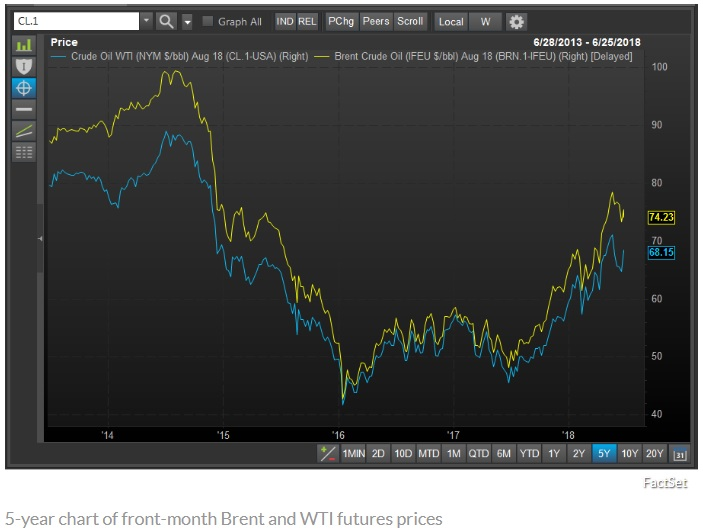Crude oil presents trading opportunities that are often fundamentally driven. And in the US, many retail traders prefer trading the West Texas Intermediate (WTI) crude oil futures contract (ticker: CL) not only because it is liquid, but because it’s a domestic product; one that may receive more extensive coverage by local media than its foreign counterpart, Brent Crude.
Over the decades, you may have noticed that the price between WTI and Brent tends to fluctuate. They both represent global benchmarks for high-quality crude oil. They are both correlated in price. But they also differ in price, and this difference–the spread–may at times present a trading opportunity.
This article is about…
- Identifying the qualities that differentiate Brent from WTI crude;
- Identifying the different economic factors that make their prices diverge and converge; and
- Identifying when the spread between both contracts might be tradeable.
Brent and WTI 101: Similarities That Make Them Global Benchmarks of Quality Crude
Brent and WTI crude are global “benchmarks” for high-quality crude oil as both set premium standards for “light” and “sweet” categories. But what does that mean, exactly?
Both are light in density according to a globally-accepted measurement called API gravity. This API (American Petroleum Institute) standard has a range between 10 to 70. The lighter the density, the higher the API gravity. Light crude oil can float on water; heavier oils will sink.
The lighter the density, the easier it is to refine into gasoline.
Both are also sweet in that they contain less than 0.5% sulfur content than other oils. Oils that have greater than 0.5% sulfur are considered “sour.”
The lower the sulfur content, the easier it is to refine into gasoline.
Both Brent and WTI blends make for the lightest and sweetest crude oils available on the global market, hence they are both “benchmarks.”
The Differences That Make the Brent-WTI Spread Potentially Tradeable
Quality: WTI is both lighter and sweeter than Brent.
- WTI API gravity is 39.6 while Brent is around 38.
- WTI also has lower levels of sulfur, 0.24%. Brent has 0.40%.
So, from a “quality” perspective, WTI should trade at a premium over the Brent price and this has been the case for most of the spread’s history. WTI has on average held a $2.50 to $4.00 premium above Brent crude.
Currently though, this is not the case. Brent is trading at a premium over WTI. It has been for some time. The spread, however, is beginning to narrow.
This just shows us that if “quality” is a factor that influences price, another equally important factor is “location” and to that, we can add yet another: geopolitics.
Location:
- WTI extraction is landlocked. The oil fields’ location is in the U.S., mainly Texas, North Dakota, and Louisiana. WTI is traded on the NYMEX (a CME Group exchange).
- Brent, on the other hand, is extracted from the North Sea. It is delivered via shipping, making it easier for delivery to Europe and other countries within the vicinity. Brent is traded on the Intercontinental Exchange (ICE).
Geopolitics:
In 2011, events surrounding what became known as the Arab Spring caused Brent prices to rise $25 above WTI. Fears that the Suez Canal and Straits of Hormuz were going to be closed were the main geopolitical factors driving Brent prices upward.
In 2015, Iran agreed to increase flows into the market (a market whose prices were benchmarked to Brent crude), and the U.S. increased its WTI exports while its domestic rig counts were declining. Due to the increase of supply to oil markets benchmarked to Brent, prices fell while WTI prices rose due to a decrease in U.S. production and supply, as U.S. exports were increased.

Image source: MarketWatch
Takeaway: Both Brent and WTI are correlated. But both products also have wide differences that can cause their prices to fluctuate relative to one another. Understanding these fundamental differences may provide opportunities to those traders who are interested in trading the spread between both products.
There is a substantial risk of loss in trading futures, options and forex. Past performance is not necessarily indicative of future results.